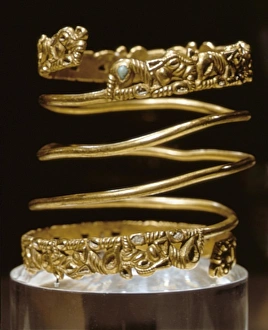Enamelling Collection (#6)
Enamelling, a centuries-old art form, has adorned various objects throughout history
For sale as Licensed Images
Choose your image, Select your licence and Download the media
Enamelling, a centuries-old art form, has adorned various objects throughout history. From Catalan pharmacy pots to European women holding enamelled boxes, the beauty of ceramics and intricate designs have captivated many. The delicate strokes of gouache on paper depict an elegant woman in Dutch attire showcasing her prized possession - an enamelled box. Gothic-style enameled gold plaques showcase the craftsmanship and attention to detail prevalent during that era. A tikka from the mid-19th century dazzles with diamonds, emeralds, pearls, and enamel intricately woven together. Similarly, a pendant from the same period boasts sapphires, emeralds, rubies, diamonds, pearls - all set against a backdrop of gleaming gold. The Two Crowned Martyrs piece takes us back to c. 1200-10 with its enchanting blend of enamel on copper and glass. An enamelled gold belt buckle transports us to 1650-1700 when such accessories were highly sought after for their elegance and sophistication. Moving across continents to Iran's King Darius winter palace at Susa in 1933-1934 reveals a mesmerizing lion frieze crafted using enamel techniques. Meanwhile, a bracelet from the 2nd century BC showcases how even ancient civilizations recognized the allure of combining gold with turquoises through exquisite enamelling. Antique treasures continue to amaze as we encounter an enamel and pearl pendant featuring drop-shaped pearls surrounded by white, red green & blue enamel delicately applied onto golden lac core. Lastly but not leastly is Limoges' little reliquary chest from the 13th century; gilt copper combined with vibrant enamel creates an awe-inspiring masterpiece that preserves precious relics within its ornate design. Through these diverse examples spanning centuries and cultures alike, enamelling emerges as both an art form and testament to human creativity.












